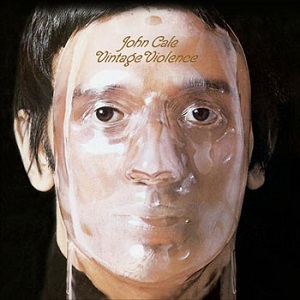 After leaving the Velvet Underground in 1968, John Cale—arguably the band’s most accomplished musician—dabbled in production and session work, before finally putting out his first solo album in 1970. Vintage Violence actually beat Loaded into the stores by about six months, but was even less of a hit.
After leaving the Velvet Underground in 1968, John Cale—arguably the band’s most accomplished musician—dabbled in production and session work, before finally putting out his first solo album in 1970. Vintage Violence actually beat Loaded into the stores by about six months, but was even less of a hit.It’s an oddity of an album, consisting mostly of straightforward rock songs based around his pounding piano, colored by country-styled electric guitar and crisp drums. The lyrics don’t always click, but the songs are so catchy the meanings don’t matter. His voice is generally double-tracked, and not always in sync. Throughout, the then-unknown Garland Jeffreys wails along in harmony. (His band Grinderswitch, or maybe it was Penguin, was tapped for the sessions, including the legendary Harvey Brooks on bass, onetime Dylan drummer Sandy Konikoff, and erstwhile Band member Stan Szelest. Co-producer was Lewis Merenstein, right between Astral Weeks and Moondance.)
“Hello, There” is the obvious choice for an opener, though it pits an incongruous verse against a rather pedestrian chorus. “Gideon’s Bible” is equally inscrutable lyrically, but the soaring chorus incorporates pedal steel and Cale’s viola for a lovely mix. Punctuated throughout by a honking harmonica with occasional vocal interjections, “Adelaide” starts out as a yearning for the city, but seems to be about a woman by the end. “Big White Cloud” creeps in with sweeping “Expecting To Fly” strings for a big production, while “Cleo” harkens back to ’50s-style pop, complete with a female backing vocal. “Please” sports a lovely melody despite the outlandish rhymes (“Won’t you help me please, I’m growing old” followed by “Won’t you help me sneeze, I’ve caught a cold”). Clearly, he’s not going for profundity.
Side two is equally all over the map; “Charlemagne” brings back the pedal steel for a more expansive sound, but it mostly lopes along the plains like a lonesome cowboy, even with the reference to his uncle being a “vicar”. “Bring It On Up” is pure chugging boogie, though you can just barely hear the viola sawing away beneath the mix. The three-song juxtaposition of the solo acoustic “Amsterdam” (only two major-seventh chords throughout), the fittingly nightmarish “Ghost Story”, and the simple “Fairweather Friend”, which Jeffreys wrote, demonstrates his refusal to be pigeonholed.
Possibly because it’s one of his more accessible albums, Vintage Violence was treated to a slight expansion come the 21st century. Liner notes give just a little more info on how and why the album came together, and exactly two bonus tracks are included: a nearly identical alternate take of “Fairweather Friend” plus six minutes of layered, droning violas called “Wall”, which becomes something of a preview of his next album.
John Cale Vintage Violence (1970)—3
2001 remastered CD: same as 1970, plus 2 extra tracks
Nice review. I like the album. Would be keen to read your take on Slow Dazzle.
ReplyDeleteIt's on the list to get to!
Delete